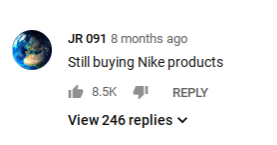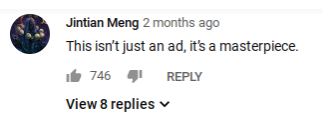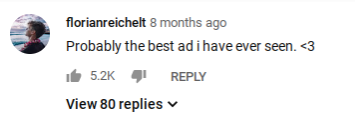LEAP #2: A Comparison and Contrast of NIKE Campaigns: Equality Vs. Dream Crazy
- deborahsareth

- May 9, 2019
- 11 min read

“Equality” Vs. “Dream Crazy”
Stephen MacDonnell and Deborah Sareth
COM 416: Propaganda
LEAP 2
Abstract
For our Leap 2 Assignment we chose to compare and contrast the Nike ad campaigns “Equality” and “Dream Crazy.” The “Dream Crazy” Campaign centers around the idea that nothing is impossible. The ad itself presents the idea that no dream is too crazy to come true, as long as it is accompanied by hard work and commitment. “Dream Crazy” is a supplement to the situation with the NFL and Colin Kaepernick, who, willingly decided to take a knee during the National Anthem during a game. He is not the first person to do so; but individually, Kaepernick became a catalyst and a symbol for movement that can only be described as: propaganda. In the “Dream Crazy” advertisement, Kaepernick is doing a voice-over as the video presents a collection of stories from diverse athletes, who each serve as representations of success and inspiration for the campaign. The “Equality” campaign originates from back in 2017, and centers around the premise: no matter who you are, or where you come from, we are all equal. The “Equality” campaigns encourages well-known athletes to spread the agenda of the equality campaign, by using their influence on social media platforms to spread equality propaganda. These two campaigns from different time periods are both examples of propaganda. Both campaigns have many similarities, as well as many differences, in presentation, message, impact on audience that we will discuss in more depth throughout this essay. We will also analyze the use of varying propaganda techniques in both campaigns that have been discussed in COM416 to examine whether or not Nike’s propaganda was effective.
Comparison: Stephen
Nike was very smart in the way they released these ads and they way they use them to relate to each other. There are many similarities between the ad campaigns “Dream Crazy” and “Equality”. The first and probably most obvious one is that they are heavily influenced by sports. In the “Dream Crazy” campaign, almost all of the clips revolve around sports. Whether it is training for a marathon, practicing on the football field, or swimming laps, almost all the sports are represented in the ad. In the “Equality” ad it is mainly focused around basketball but also has hints at other sports as well. Sports are a massive part of the world and professional athletes have a huge platform when it comes to having people hear their opinions.
Both of the ad campaigns are clearly heavily influenced by sports, but rather than include a single sport, a wide variety is included. Both the “Equality” and the “Dream Crazy” campaigns show the big sports like football, soccer, baseball and basketball. In addition to those “bigger” sports, they include boxing, track, tennis, and even surfing. In addition to showing a wide variety of sports, the ad campaigns show these sports being played in different settings. This is appealing to audiences because the majority of athletes will never play on a professional field. Many of us play in our backyards, cul-de-sacs and local school fields. These choices of setting make the ad campaigns much more relatable to a wider audience.
Transitioning from the idea that both of these ad campaigns revolve around the idea and pastime of sports, both of these ads selected the people represented very strategically in order to reach a wide audience. Both have a wide variety of cultures and races represented from those with disabilities, women wearing traditional hijabs, African Americans, Caucasians, and children. Previously, and unfortunately still today, many companies did not diversify their ad campaigns, which ultimately made them hard for many to relate to. Even if you are not an athlete, both of these advertisements have an actor or actress that you feel connected to.
The diversity in the representation is mirrored in the voice over playing in back of both of the ad campaigns. Athletes are an inspiration for many children, young adults and even adults. Often, these people seem larger than life and impossible to compare to any aspect of life we know. “Here you’re defined by your actions. Not your looks or beliefs” is one of the passages that stood out to me from the “Equality” campaign. Sports provide an outlet for many and an environment in which they are “judged” for nothing besides their talent. As discussed in the previous paragraph, the diversity of representation goes along with this voice over very well. For those who look different than a “typical” athlete, it is important for them to feel that they are on an equal playing field. By saying “you are defined by your actions,” NIKE is encouraging people to look past the initial appearance of people and into the skills that they possess and what they can bring to the table.
A passage of the “Dream Crazy” ad campaign that stuck out to me was, “don’t ask if your dreams are crazy, ask if they’re crazy enough.” This was said at the end of the ad, following two minutes of encouraging words to be above average. Although not exactly the same message as the “Equality” ad campaign, both are encouraging people to be the best they can be, not matter what challenges or obstacles may stand in the way of your journey. Both the “Dream Crazy” and “Equality” ads strategically chose their voice-over to go along with the images and message they are portraying. The images of “non-typical” athletes coinciding with inspirational words encourage potential customers that wearing NIKE attire will help you be your best self and demonstrate your skills to their full potential. That is why both of these ad campaigns chose the theme they did for their voice overs.
Both of these campaigns structure the organization of their videos strategically. Throughout both ads, professional athletes are shown throughout. Rather than having the entire commercial being based on professional athletes, they include others throughout in order to demonstrate the process and journey of getting to where some of these athletes are now. In the “Dream Crazy” campaign, children are shown throughout the clip. This is intentionally done in order to show that everyone starts somewhere, and hard work and determination can take you anywhere. In the “Equality” campaign, the athletes are weaved throughout with ordinary people. This shows that the professional athletes that we hold so high are really people just like us who put their drive into action and were successful. The choice to incorporate professional athletes into both of these ads is engaging to viewers as well. Seeing people that you look up to wearing attire that you might wear makes you feel a connection with someone who you otherwise may not.
Both the “Equality” and “Dream Crazy” NIKE campaigns use positive words of encouragement and inspiration, diversity of setting, people and sports, and demonstration of the importance of drive and determination to help audiences feel a connection to the brand. These ads encourage consumers to buy NIKE products because they make everyone feel important.
Dream Crazy: Deborah
Nike’s mantra is simple and straightforward: “Just do it.” It is a powerful call to action for athletes everywhere (even to those who do not purchase or endorse Nike); and consequently, it is also a form of propaganda. The company uses activation of emotion (often times through the controversy of their campaigns) as a propaganda technique. This can be seen “Dream Crazy” and “Equality.” Like any other company, Nike wants publicity. Publicity is described in the Lexicon of Lies as, deliberate, systematic campaigns to persuade. [Jack, 4].
Both Nike campaigns are what Caroline Jack from the Lexicon of Lies would classify as, “persuasive information campaigns [which] present a mixture of facts and and interpretations that aim to link brands, people, products or nations with certain feelings, ideas, attitudes.” [Jack, 4]. Jack continues by stating that the blending of facts and interpretations can make the “accuracy” of such campaigns difficult to assess. But the point of the campaign may be precisely to blur them. In order to activate emotion, Nike chose a controversial celebrity. It was purposeful, and the intent was garner more publicity through human emotions like anger (for those who were not in support of Kaepernick at the time). These individuals displayed much animosity and distress from Kaepernick just taking a knee in solidarity. These individuals were angry at Kaepernick and various other athletes for what they viewed as disrespectful. “The most powerful predictor of what spreads online is anger.” [Holiday, 2013, p.63]. This is why “Dream Crazy” was able to go as viral as it did.
Nike has a history of provocative marketing campaigns, but “Dream Crazy” in particular achieved virality that its counterpart, “Equality,” did not come close to achieving. The campaign involving Colin Kaepernick (and the controversy surrounding the him) was planned for and relied on extreme emotional responses. “Extremes in any direction have a large impact on how something will spread.” [Holiday, 2013, p.63].
“Kaepernick ignited a national discourse in 2016 when he began kneeling during the playing of the national anthem before games to protest racism, social inequality, and police brutality. He left the 49ers...but executives throughout the N.F.L considered him radioactive because of his on-field protests, which drew vocal criticism from President Trump.” [Creswell, Draper, Maheshwari, 2018]. Kaepernick became a polarizing figure, along with many other football players, who kneeled during the National Anthem. Football fans, athletes, and consumers of Nike products were in a divide. While many were in support of kneeling and the freedom to protest; others exclaim that it represents attitudes that are ‘unpatriotic’ and ‘disrespectful.’
A Colorado man took matters into his own hands, boycotting Nike inventory in his memorabilia sports store, to take a stand against the company. He claimed, “being a sports store without Nike is like being a gas station without gas…[but] this was never about property to me, this was about principle.” This Colorado store owner may not have received Nike’s propaganda well, but definitely gave Nike what they wanted as his individual story gained traction in headlines. Dozens of similar boycotting cases were reported on too. “Many Nike customers...filmed themselves destroying Nike products and claiming they will boycott the company.” [Martinez, 2018]. “Despite the backlash, in the wake of Nike’s endorsement deal with Colin Kaepernick, the sportswear company has seen a 31% increase in online sales.” [Martinez, 2018].
Using the ten methods to analyze propaganda, presented in “How to Analyze Propaganda” [Jowett, O’Donnell, 2005]. We will continue to examine the “Dream Crazy” and “Equality campaigns in further detail, starting with “Dream Crazy.” The ideology was: don’t ask if your dreams are crazy, ask if they’re crazy enough. The purpose of the ideology was to motivate athletes to push boundaries in sports and move forward; while the purpose of the campaign was to release a social statement (using Kaepernick's face and what he kneeled for) to get attention. The release of this campaign is during a time of racial discourse within the nation; where discrimination runs rampant and political agendas remain at opposite ends of the spectrum. This was also when #BlackLivesMatter was propaganda was everywhere. What’s interesting is that I believe that even thought it was not a time of volatile warfare; the war is internal. The fight was between two different propagandas, unwilling to compromise or hear the other out.
Being that Nike is multinational billion-dollar company, it’s safe to say that the company holds tremendous amounts of influence. Their propaganda is sown into every product they sell, including their campaigns. The Nike check mark today is its own form of Nike propaganda, holding the weight of Nike values and company standards behind it. Nike states on their website, “our purpose is to use the power of sports to move the world forward. We believe in a fair, sustainable future--one where everyone thrives on a healthy planet and level playing field.” Which is evident in the Dream Crazy campaign. Through this campaign, Nike hopes to target their consumers, athletes, and anyone who enjoys sports (playing or watching).
By using Youtube alone, the Dream Crazy official ad has acquired MILLIONS of views. The official video ad was an example of visual propaganda; and there is a statement beneath the video that reads: “Don’t ask if your dreams are crazy. Ask if they’re crazy enough.” Followed by the quote spoken by Kaepernick himself: “Believe in something, even if it means sacrificing everything.” Which can be seen as a metaphor when considering Kaepernick’s choice to leave the 49ers and become a free agent, risking his entire career. Both quotes are powerful, and advanced the success of the campaign. Unlike its counterpart “Equality,” the “Dream Crazy” video was produced in entirely color, narrated by Kaepernick. By using vivid imagery, suitable background music, and rich script from the collection of athletes, Nike sets the perfect tone for their campaign. “Dream Crazy” is an example of successful propaganda. It went viral and got views, boosted sales revenue, received positive feedback from audiences, and made a social statement using Kaepernick. It became so viral that another ad, titled, “Dream Crazier,” was subsequently released; which did not happen with the “Equality” campaign. The comments and reactions below the video speak for the success of the campaign itself. (See below).
Equality: Deborah
To analyze “Equality,” we have to first set the right tone by bringing attention to Nike’s statement about their team, described as “a team that’s empowered, diverse, and inclusive.” The ideology behind “Equality?” Worth should outshine color. The purpose of the propaganda? It was the same as “Dream Crazy.” To motivate and to inspire. “Equality” was circulated one year before “Dream Crazy,” in similar contexts in light of #BlackLivesMatter, police brutality, and the attention brought to racial injustice. Yet, it only received a little over 100k views on Youtube. (It is important to note that the original video cannot be found on the official Nike Youtube page.) “The anchor of the Equality campaign is a short film of the same title, done with agency Wieden + Kennedy, directed by Melina Matsoukas. It features Nike athletes, including Lebron James, Serena Williams, Kevin Durant...amplifying their voices in an effort to uplift, open eyes and bring positive values that sport can represent in a wider focus. [O’Brien, Feb. 2017]. Underneath the video, there is a statement that reads, “Encourage people to take the fairness and respect they see in sports and translate them off the field.” The “Equality” Campaign was under the same organization as “Dream Crazy,” which was Nike and attempted to get attention from the same target audience.
The only different technique that was used to maximize the effect was the cameo of well-known celebrities (well-known even by individuals who don’t follow sports, like myself.) And while Kaepernick is pretty famous now, before the “Dream Crazy” campaign, I had no idea who he was or what he stood for. That being said, the “Equality” campaign relied heavily on the influence, to an error; and the publicity that would be gained from featuring easily, and widely-recognized athletes. To cameo numerous famous faces took away from the message. The message of propaganda was overshadowed by another propaganda technique; and to be successful, both the techniques that are used need to enhance and support the message, not take away. The presentation of the ad attempted to be dramatic, but instead came off lackluster from stemmed the black and white filter. Narration was done by Michael B. Jordan, who appeared about 45 seconds into the 1 minute and 30 second ad.
While the comment section under “Dream Crazy” was flooded with positive response, the comments for “Equality” are less than positive--more accurately described as a gathering of trolls and cynics who serve the role of counter-propaganda. (See below).
In conclusion, Nike is company that exemplifies modern propaganda. They are media manipulators, with the ability to anticipate what will spread and what won’t. True success comes from improvement, and the success from “Equality” back in 2017 to “Dream Crazy” in 2018 was impressive. Both used similar techniques, had similar messages, were produced by Wieden + Kennedy, and had similar context; but it was was differentiated them that caused one to become a headliner and one to fall through the cracks.
Works Cited
Almasy, S., & Alsup, D. (2019, February 15). Colorado store that boycotted Nike after Colin Kaepernick ad will close. Retrieved from https://www.cnn.com/2019/02/14/us/colorado-store-closing-nike-boycott/index.html
Creswell, J., Draper, K., & Maheshwari, S. (2018, September 26). Nike Nearly Dropped Colin Kaepernick Before Embracing Him. Retrieved from https://www.nytimes.com/2018/09/26/sports/nike-colin-kaepernick.html
Holiday, R. (2013). Trust me, I’m lying: Confessions of a media manipulator. NY, NY: Portfolio/Penguin.
Jack, C. (n.d.). Lexicon of Lies: Terms for Problematic Information. Retrieved from https://datasociety.net/pubs/oh/DataAndSociety_LexiconofLies.pdf
(n.d.). Retrieved from https://writingcenter.unc.edu/tips-and-tools/comparing-and-contrasting/
Martinez, G. (2018, September 08). Nike Sales Increase 31% After Kaepernick Ad Despite Backlash. Retrieved from http://time.com/5390884/nike-sales-go-up-kaepernick-ad/
Nike's New Just Do It Campaign. (n.d.). Retrieved from https://news.nike.com/featured_video/just-do-it-dream-crazy-film
Nike reveals a powerful equality campaign. (2017, February 13). Retrieved from http://www.media-marketing.com/en/news/nike-reveals-a-powerful-equality-campaign/
O'Brien, K. (2017, February 12). Nike uses the power of sport to take a stand for equality in new campaign. Retrieved from https://www.thedrum.com/news/2017/02/12/nike-uses-the-power-sport-take-stand-equality-new-campaign
Propaganda Techniques | Mind Over Media. (n.d.). Retrieved from https://propaganda.mediaeducationlab.com/techniques












Comments